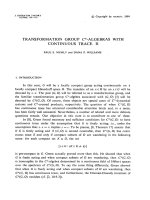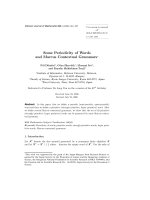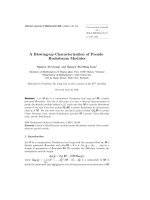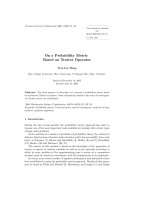Báo cáo toán học: "How different can two intersecting families be" ppsx
Bạn đang xem bản rút gọn của tài liệu. Xem và tải ngay bản đầy đủ của tài liệu tại đây (92.62 KB, 7 trang )
How different can two intersecting families be?
Bal´azs Patk´os
Department of Mathematics and its Applications
Central European University, Budapest, Hungary
Submitted: Mar 7, 2005; Accepted: May 9, 2005; Published: May 16, 2005
Mathematics Subject Classification: 05D05
Abstract
To measure the difference between two intersecting families F, G⊆2
[n]
we in-
troduce the quantity D(F, G)=|{(F, G):F ∈F,G ∈G,F ∩ G = ∅}|.Weprove
that if F is k-uniform and G is l-uniform, then for large enough n and for any i = j
F
i
= {F ⊆ [n]:i ∈ F, |F | = k} and F
j
= {F ⊆ [n]:j ∈ F, |F | = l} form an optimal
pair of families (that is D(F, G) ≤ D(F
i
, F
j
) for all uniform and intersecting F and
G), while in the non-uniform case any pair of the form F
i
= {F ⊆ [n]:i ∈ F } and
F
j
= {F ⊆ [n]:j ∈ F } is optimal for any n.
1 Introduction
To answer the question of the title, we first have to find out how to measure the difference
between two intersecting set systems F, G⊆2
[n]
. If for any F ∈Fand G ∈Gwe have
F ∩ G = ∅,thenF∪Gis still an intersecting system of sets, so F and G are not really
different as they are subfamilies of the same maximal intersecting family. So the evidence
of being different (at least in this sense) is a pair (F, G):F ∈F,G ∈G,F ∩ G = ∅.
Therefore it seems natural to introduce
D(F, G)=|{(F, G):F ∈F,G∈G,F ∩ G = ∅}|
to measure the difference between F and G. Our purpose is to get optimal set systems
F
∗
, G
∗
(i.e. ones with the following property: D(F, G) ≤ D(F
∗
, G
∗
) for any pair of
intersecting families).
In fact, we will handle two different cases: first, when there is a restriction on the
cardinality of the sets belonging to F and G (F and G will be uniform set systems), and
secondly, when there is not. In both cases one can consider these hypergraphs:
F
i
= {F ⊆ [n]:i ∈ F }
the electronic journal of combinatorics 12 (2005), #R24 1
Observe that, when considering the pair F
i
, F
j
, all the sets containing both i and j are
not contained in any disjoint pairs, so the D-number won’t decrease if we throw these
sets away getting
F
i,j
= {F ⊆ [n]:i ∈ F, j /∈ F }, F
j,i
= {F ⊆ [n]:j ∈ G, i /∈ G}
These pairs of hypergraphs will be referred as the conjectured hypergraphs/set systems.
In section 2, we will show that in the uniform case the conjectured set systems fail to be
maximum with respect to D(F, G) for small n, but they are optimal if n is large enough
(depending on the cardinality of the elements of F and G). Note that in the uniform case
D(F
i
, F
j
)=D(F
i,j
, F
j,i
)=
n−2
k−1
n−k−1
l−1
. In section 3, we will prove that in the non-
uniform case the conjectured set systems are optimal for all n.ThistimeD(F
i
, F
j
)=
D(F
i,j
, F
j,i
)=3
n−2
, because when considering a disjoint pair of sets F
i
∈F
i,j
,F
j
∈F
j,i
,
then any k ∈ [n] \{i, j} can be either in F
i
or in F
j
or in none of them.
2 The Uniform Case
Throughout this section we will assume that F is k-uniform and G is l-uniform. Now if
k + l>n, then there are no disjoint k and l element subsets.
If k + l ≤ n, but, say, l>
n
2
,thenanytwol-element subsets meet each other. For any
fixed k-element subset there are
n−k
l
l-element subsets disjoint from this fixed set. So
the best one can do is to let F be the largest intersecting k-uniform set system, and let
G consist of all l-element subsets disjoint from at least one set in F. The Erd˝os-Ko-Rado
theorem [1] says that F should be all k-element sets containing a fixed element, so then
G should be all l-element sets not containing this fixed element. Thus in this case the
conjectured set systems are not optimal.
If 2k = n and k = l then any set has only one disjoint pair (considering now only
the k-element sets), its complement. So one can put from each pair one set into F and
one into G, and since in this way subsets containg 1 and n together (or containing none
of them) will be put into F or G, these families will have more disjoint pairs, than the
conjectured systems (and clearly will be maximal ones).
Despite these failures of the conjectured systems, one can state the following
Theorem 2.1. For any k and l, there exists an n(k, l) such that if n ≥ n(k, l) and
F, G are k and l-uniform hypergraphs , then D(F, G) ≤ D(F
0
, G
0
) where F
0
, G
0
are the
conjectured hypergraphs.
Proof: Case A
F= ∅ and
G= ∅.
In this case
F and
G must be disjoint, since otherwise there would be no disjoint
sets in F and G.Let’spickani ∈
F and a j ∈
G,andadd{F ⊆ [n]:i ∈ F } to F
and {G ⊆ [n]:j ∈ G} to G. In this way we get the conjectured hypergraphs, and clearly
D(F, G) can’t decrease.
Case B
F = ∅. (or similarly
G = ∅)
the electronic journal of combinatorics 12 (2005), #R24 2
Observe the following two things:
1, if n ≥ k +2l then again by [1] one gets that for a fixed F ∈F the number of sets
in G from which F is disjoint is at most
n−k−1
l−1
, which is the case in the conjectured
hypergraphs for all sets in F
i,j
.Soif|F| ≤ |F
i,j
| =
n−2
k−1
then we are done.
2, Since
F = ∅ then as a special case of Theorem3 of [2] we get that
|F| ≤ 1+
n − 1
k − 1
−
n − k − 1
k − 1
and as for large enough n
n − 2
k − 1
> 1+
n − 1
k − 1
−
n − k − 1
k − 1
holds, by the remark made after the first observation we are done.
3 The Non-Uniform Case
Considering the non-uniform case one can assume that the pair (F, G) is maximal with
respect to the property that all F ∈F have at least one G ∈Gdisjoint from it (and the
same holds for any G ∈G). First we state our main theorem.
Theorem 3.1. For any F, G⊆2
[n]
and for any n ≥ 2, D(F, G) ≤ D(F
i,j
, F
j,i
) holds,
where F
i,j
, F
j,i
are one of the conjectured pairs.
Proof: We begin with
Claim 3.2. F ∈F⇔F
c
∈G, where F
c
denotes the complement of F .
Proof: If F ∈Fthen there is some G ∈Gsuch that F ∩ G = ∅. This means G ⊆ F
c
,
and as G meets all sets in G, F
c
meets them, too. So by maximality F
c
∈G. The other
direction follows, since we can change the role of F and G.
3.2.
By virtue of the above claim, we can “forget about” G. But what should we count,
and are there any additional conditions on F? Concerning the first question: as for a
fixed F we counted the Gs disjoint from it, and since F ∩ G = ∅⇔F ⊆ G
c
,bytheclaim
we get, that now for a fixed F we should count the number of F
∈F: F ⊆ F
.(Note
that F ⊆ F also counts, because this is for the pair (F, F
c
)!) Let’s denote this number
by ρ
F
(F ) (and we will omit F from the index, if it is clear from the context), and put
ρ(F)=
F ∈F
ρ
F
(F ).
Now to the other question: since by the above claim we know that G = F
c
= {F
c
:
F ∈F}and the original conditions were that both F and G should be intersecting, we
get that F should be intersecting and co-intersecting. So we conclude the following
Claim 3.3. max{D(F, G):F, G are intersecting} =max{ρ(F):F is intersecting
and co-intersecting}.
By this claim we are left to show that ρ(F) ≤ ρ(F
i,j
) whenever F is an intersecting
and co-intersecting family.
the electronic journal of combinatorics 12 (2005), #R24 3
Now note that, when counting ρ(F) one counts the pairs (F, F
)whereF, F
∈F
and F ⊆ F
. But this can be done from the point of view of F
, that is, if we put
δ
F
(F
)=|{F ∈F: F
⊇ F }| and δ(F)=
F ∈F
δ
F
(F ), then ρ(F)=δ(F). With this
remark we are able to prove
Lemma 3.4. If F is intersecting and co -intersecting, furthermore
F= ∅, then
δ(F) ≤ δ(F
i,j
).
Proof: W.l.o.g. one can assume that 1 ∈ F for all F ∈F. Consider the hypergraph
F
∗
= {F \{1} : F ∈F}. Since we removed 1, this need no longer be intersecting, but it
is clearly co-intersecting on [2, , n], furthermore δ
F
(F )=δ
F
∗
(F \{1}).
It is well-known, that if a hypergraph is maximal co-intersecting, then it contains one
set from any pair of complements, and if F ⊆ F
∈F
∗
,thenF ∈F
∗
.Soδ
F
∗
(F \{1})=
2
|F \{1}|
, hence to obtain the largest δ(F
∗
) one should put the most possible large sets into
F
∗
. Again, by [1], we know that for fixed k ≥
n−1
2
we can put at most
n−2
k
k-element
sets into F
∗
, but in the case of any conjectured hypergraph (any F
i,j
, or as we assume
now that 1 ∈
F any F
1,j
) exactly that many sets (now with k + 1-elements, as we put
back 1 to all the sets) are there. So for all k we put the most possible number of large
sets into our family when considering the k and n − 1 − k-element complementing pairs.
3.4.
So we will be done, if we can prove
Lemma 3.5. For any intersecting and co-intersecting family F, there exists another
F
with
F
= ∅ and ρ(F) ≤ ρ(F
).
Before starting the proof of Lemma 3.5., we introduce some notation: the shift oper-
ation τ
i,j
is defined by
τ
i,j
(F )=
F \{j}∪{i} if j ∈ F, i /∈ F andF \{j}∪{i} /∈F
F otherwise
(1)
Put τ
i,j
(F)={τ
i,j
(F ):F ∈F}.
It is well-known that the shift operation preserves the intersecting and co-intersecting
property. It is also known, that starting from any family of sets, performing finitely many
shift operation, one can obtain a so-called left-shifted family, that is a family for which
τ
i,j
(F)=F for all i<j. So in what follows, we can assume that F is left-shifted, if we
can prove the following
Claim 3.6. ρ(F) ≤ ρ(τ
i,j
(F)).
Proof: We will consider how ρ(F) changes when performing the operation τ
i,j
.
Case A If i, j ∈ F or i, j /∈ F ,thenτ
i,j
(F )=F and for all F
∈F with F ⊆ F
we
have F ⊆ τ
i,j
(F
). So ρ
F
(F ) ≤ ρ
τ
i,j
(F)
(F )=ρ
τ
i,j
(F)
(τ
i,j
(F )).
Case B Let A ⊆ [n]withi, j /∈ A.PutF = A ∪{i} and F
= A ∪{j}.
Subcase B1 F ∈F,F
/∈F
Now for all G ⊇ Fi∈ G, therefore G = τ
i,j
(G) ⊇ τ
i,j
(F )=F ,thusρ
F
(F ) ≤
ρ
τ
i,j
(F)
(F )=ρ
τ
i,j
(F)
(τ
i,j
(F )).
the electronic journal of combinatorics 12 (2005), #R24 4
Subcase B2 F/∈F,F
∈F
Now τ
i,j
(F
)=F ,andifF
⊂ G ∈F with i/∈ G,then(G \{j}∪{i})=G
∈ τ
i,j
(F)
and clearly F ⊆ G
.IfF
⊆ G with i, j ∈ G,thenG = τ
i,j
(G) ⊇ F , thus we conclude,
that ρ
F
(F
) ≤ ρ
τ
i,j
(F)
(F )=ρ
τ
i,j
(F)
(τ
i,j
(F
)).
Subcase B3 F, F
∈F (thus τ
i,j
(F )=F, τ
i,j
(F
)=F
)
Now let G ∈Fcontain at least one of F,F
.Ifi ∈ G,thenτ
i,j
(G)=G contains
as many of F, F
as before performing the τ-operation. Otherwise i/∈ G, j ∈ G and G
contains only F
. So, putting G
= G \{j}∪{i},ifG
/∈F,thenτ
i,j
(G)=G
and G
⊇ F ,
while if G
∈F,thenτ
i,j
(G)=G and still F
⊆ G.Sowegetρ
τ
i,j
(F)
(F )+ρ
τ
i,j
(F)
(F
) ≥
ρ
F
(F )+ρ
F
(F
).
So for sets of type of the first case ρ(F ) doesn’t decrease, and we can partition the
sets of type of the second case into “pairs” (of which one may be missing) for which the
sum of ρ(F )s doesn’t decrease.
3.6.
Further notations:
F + G = {F ∪ G : F ∈F,G∈G}, F−G= {F \ G : F ∈F,G∈G}
∆F = F−F; SubF = {S : S ⊆ F ∈F}
And we will write 1 + F if G consists of one single set containing only 1.
Now we can return to the proof of Lemma 3.5. In the proof we will use the basic ideas
of [3].
ProofofLemma3.5. For arbitrary F intersecting and co-intersecting family we have
to define another one of which each set has an element in common. Now let F = F
0
∪
∗
F
1
,
where F
1
= {F ∈F:1∈ F } and F
0
= {F ∈F:1/∈ F }.PutF
= F
1
∪ (1 + SubF
0
).
We have to prove that i,
F
= ∅ (and therefore it is intersecting), ii, F
is co-
intersecting and iii, ρ(F
) ≥ ρ(F).
i, is clear, as by definition 1 ∈ F for all F ∈F
.
To prove ii, we will use that F is left-shifted (and maximal).
Claim 3.7. 1 + F
0
⊂F
1
Proof: Since for any F ∈F
0
F
= {1}∪F ⊃ F , F
meets all sets in F.Wehaveto
show, that there is no G ∈Fsuch that F
∪ G =[n]. Suppose to the contrary that such a
G exists. Note that 1 /∈ G, because otherwise G ∪ F =[n] would hold, contradicting the
co-intersecting property of F.NowasF is intersecting, there is j ∈ F ∩G. But since F is
left-shifted, G \{j}∪{1} = G
∈F.ButthenG
∪ F =[n] would hold - a contradiction.
3.7.
By Claim 3.7. we know that all new sets in F
are subsets of one of the old sets (that
is a set from F), therefore as F was co-intersecting, so is F
.
It remains to prove iii,. For this purpose we will define an injective mapping f : F
0
→
1 +∆F
0
(observe that ∆F
0
⊆ SubF
0
!) such that for all F ∈F
0
ρ
F
(f(F )) ≥ ρ
F
(F ).
This is clearly enough, because F
1
⊆F
,soρ(F ) can’t decrease for any F ∈F
1
(and if
F
1
,F
2
∈F
0
,then{1}∪F
1
\ F
2
is disjoint from F
2
, so, by the intersecting property of F,
it is not an element of F
1
, so we won’t count twice any ρ(F )).
the electronic journal of combinatorics 12 (2005), #R24 5
To define f (using the notation of [3]) let k =min{|I| : I = F
1
∩ F
2
; F
1
,F
2
∈F
0
}
(note, that I is not empty, as F is intersecting!) and fix F
1
,F
2
with I = F
1
∩ F
2
: |I| = k.
Now consider the following partition of F
0
:
C = {F ∈F
0
: I ⊆ F }; A = {F ∈F
0
: I ⊆ F, there is F
∈F
0
with F ∩ F
= I};
B = F
0
\ (A∪C)
For a better understanding, F ∈Bif I ⊂ F and whenever there is a set F
∈F
0
with
I ⊆ F
,thenF should meet F
outside I, as well. Note that A is not empty, since
F
1
,F
2
∈A. Now for any A ∈Alet f(A)=(A \ I) ∪{1}. (Observe that for any A ∈A
there is A
∈A⊆F
0
with A ∩ A
= I, A \ I = A \ A
,sof (A) ∈ 1 +∆F
0
as required!)
As all A ∈Acontain I, f is injective restricted to A.
To show that ρ
F
(f(A)) ≥ ρ
F
(A), observe that f(A) ⊂ A ∪{1}. Therefore if A ⊂ F ∈
F and 1 ∈ F (that is F ∈F
1
, therefore F ∈F
,too),thenf(A) ⊂ F , as well, so the
part of ρ(A) which comes from the FsinF
1
can’t decrease.
We have to handle the sets A ⊂ F ∈F
0
. Todothislet(F \ I) ∪{1} = F
.Then
F
∈F
and f(A) ⊆ F
by definition. If F = G then F
= G
, because we took the same
set I away from both (and I ⊆ F, G), and 1 was neither in F nor in G. We still have to
point out that F
is not equal to any G ∈ F
1
, G containing A for any F ∈F
0
(because
in that case we would take into account that containing relation twice when counting
ρ(f(A))). But this is clear, because a G of this form contains I (as I ⊆ A), and F
∩I = ∅
by definition (and as we pointed out I is not empty).
To finish the proof we need to continue this procedure now considering the remaining
sets, that is B∪C.SowedefineanewI
and a new k
now only considering sets in B∪C,
then get a new partition A
, B
, C
with respect to this new I
and new k
, and define f
on A
with the help of I
, and then start again with B
∪C
This procedure ends after
finitely many steps, as the As are never empty, so there is strictly less and less remainder.
In each step f is injective, the only difficulty is to assure for sets A, B on which f is
defined at different steps f(A)=f(B) can’t happen. This is clearly done by
Claim 3.8. (A−{I}) ∩ ∆(B∪C)=∅
A−{I} is the set of the f-images defined at a step (if we don’t count 1, which is an
element of all images). For a set B on which f is defined later, the image is of the form
B \ I
= B \ B
(again without 1), so it is in ∆(B∪C). Therefore by the claim we will be
really done.
Proof: This is in fact the lemma in [3], but to be self-contained we repeat the proof.
Case1: A ∈A,B ∈B,F ∈B∪C.
By the definition of B, B must meet A outside of I, too. Therefore F \ B doesn’t
contain this (these) element(s), while A \ I does.
Case2: A ∈A,C ∈C,F ∈B∪C
By the definition of C, C doesn’t contain I, therefore by the minimality of |I|, C must
meet A outside of I, too. The rest is as in Case1.
3.8.
3.5.
3.1.
the electronic journal of combinatorics 12 (2005), #R24
6
Acknowledgments. I would like to thank Gyula Katona for proposing me the prob-
lem and for helpful discussions and
´
Akos Kisv¨olcsey for his useful remarks on the first
version of this paper. I would also like to thank the anonymous referee for his/her com-
ments on the presentation of the proofs.
Research supported by the Hungarian National Research Fund (OTKA) T046991.
References
[1] P. Erd˝os, Chao Ko, R. Rado, Intersection theorems for systems of finite sets, Quart.
J. Math. Oxford (2), 12 (1961) 313-318.
[2] A.J.W. Hilton, E.C. Milner, Some intersection theorems for systems on finite sets,
Quart. J. Math. Oxford (2), 18 (1967) 369-384.
[3] J. Marica and J. Sch¨onheim, Differences of sets and a problem of Graham, Can.
Math. Bull. 12 (1969) 635-637
the electronic journal of combinatorics 12 (2005), #R24 7









